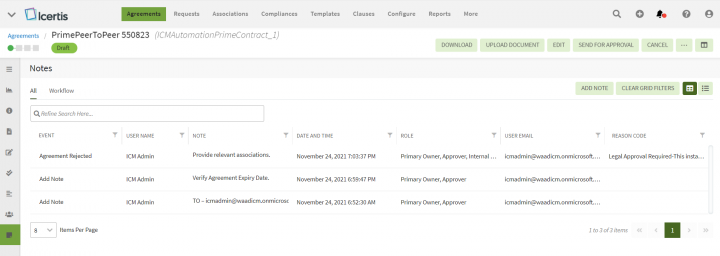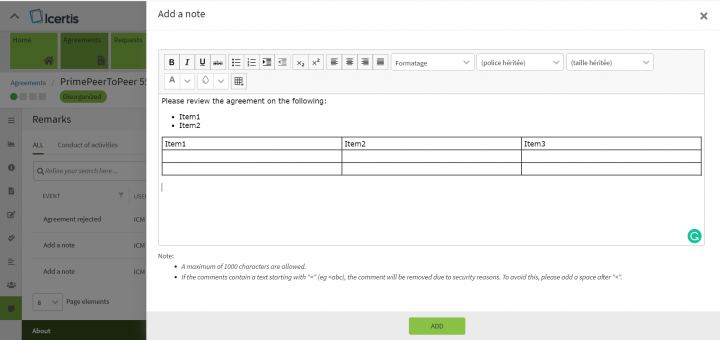Shefali DK (Talk | contribs) |
Shefali DK (Talk | contribs) |
||
| Line 64: | Line 64: | ||
*A dropdown to choose filters logic for the additional value and operator, for example – “And”, “Or”. | *A dropdown to choose filters logic for the additional value and operator, for example – “And”, “Or”. | ||
*Fields to enter an additional set of values and operator. | *Fields to enter an additional set of values and operator. | ||
| + | |||
| + | The applied filters can be cleared using the "Clear Grid Filters" button on the right above the grid beside the view buttons. | ||
<div class="image-green-border">[[File:8.0-Versions-filters.png|320px|8.0-Versions-filters.png]]</div> | <div class="image-green-border">[[File:8.0-Versions-filters.png|320px|8.0-Versions-filters.png]]</div> | ||
| | ||
Revision as of 17:48, 25 November 2021
Notes
The "Notes" tab displays the comments that are added to the Agreement either when an action is taken or directly through the "Notes" tab. It displays the comments for the complete lifecycle of the Agreement.
Internal users can communicate more efficiently with both internal and external sources through "Notes" across all phases of an Agreement. While adding them, internal users have the choice of making their Notes visible to all users (internal and external) or to internal users only. ICI handles the validation of users and displays Notes based on their visibility settings.
By default:
- Notes added by internal users are visible only internally.
- Notes added by external users are visible to all.
The "Notes" can be viewed either using the "Grid" or "List" view. By default, the "Grid" view is selected. The grid columns get auto-fit with the collapsing and expanding of the left navigation pane.
To add notes using the "Notes" tab:
1. Click the "Agreements" navigation menu on the top. This opens the Agreements Index page listing all agreements in a grid by default.
2. Click the "View Details" eye icon in the last grid column of the agreement for which you want to view the notes. The Agreement Details page opens.
3. Click "Notes" on the left pane to view notes in a grid view by default (Note: The "Notes" tab is visible in collapsed left pane if configured else expand the left pane to see the tab). If no notes are available for an agreement, an image and a message depicting “no records” are displayed in the grid area.
4. Click the "Add Note" on the right above the grid. This opens the "Add Note" drawer slides from the right.
5. Enter your comments.
6. Click "Add". The added comment is listed on the grid.
7. Click "List View" on the extreme right to change the view from the gird to the list.
Let’s go through each view in detail:
Grid View
Grid view dramatically reduces the time required to go through the complete list of logs to find a specific one. Through this view, you can easily refine your search for any specific log. The search results are displayed in tabular form.
1. You can refine your search by selecting the provided categories in tabs:
-
- All: displays the logs added directly through the Notes tab and while taking any action on the Agreement.
- Workflow: displays the logs added while taking any action on the Agreement.
For example,
In the screenshot below, three notes are displayed under the "All" tab.
-
- The first row shows the note created while the "Agreement Rejected" event with a Reason code displayed under the "Reason Code" column.
- The second row is the note created from "Add Note" on the "Notes" page.
- The third row is the note created from triggering the broadcast message from the "Broadcast" page. This note has a "TO-email address" format under the "Note" column.
2. Refine your search further using the "Refine Search Here" provided below the tabs. For example, you can either type the initials of the User Name who created the Agreement or type initials of the Event and click the search icon in the extreme right. This filters the results to display only those records that match your search.
3. You can sort and filter your search results further by clicking the sort or on the column heading and the "Filter" ![]() icon provided at the right of each column heading.
icon provided at the right of each column heading.
Each column filter has these elements:
- A dropdown to choose the desired operator, for example: “Is equal to”, “is not null”, “Is before” (for “Date and Time” column) etc.
- A field to enter a value, like a keyword text or date (for “Date and Time”).
- A dropdown to choose filters logic for the additional value and operator, for example – “And”, “Or”.
- Fields to enter an additional set of values and operator.
The applied filters can be cleared using the "Clear Grid Filters" button on the right above the grid beside the view buttons.
List View
The List view displays the complete list of comments available similar to the grid but in card format. You can refine your search by selecting either "All" or "Workflow" tabs. The "Add Note" and "Clear Grid Filters" can be viewed under More Actions 3-dots on the top right similar to the grid view based on the screen zoom.
Related Topics: Agreement Management | Agreements | Requests | Agreement Details Page | Broadcast | Application Settings





